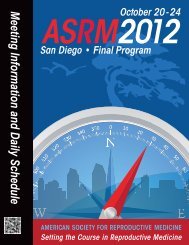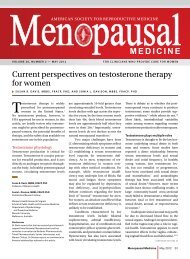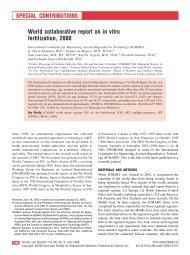scientific program • symposia - American Society for Reproductive ...
scientific program • symposia - American Society for Reproductive ...
scientific program • symposia - American Society for Reproductive ...
You also want an ePaper? Increase the reach of your titles
YUMPU automatically turns print PDFs into web optimized ePapers that Google loves.
V-7 12:15 PM<br />
WHAT DO PATIENTS THINK ABOUT FERTILITY PRESERVATION?<br />
S. J. Silber. Infertility Center of St. Louiss, St. Luke’s Hospital, St.<br />
Louis, MO.<br />
OBJECTIVE: To gain the perspective of women about<br />
whether to freeze ovarian tissue if they are about to<br />
undergo sterilizing cancer treatment, or <strong>for</strong> women who are<br />
concerned about their biological clock.<br />
DESIGN: We have interviewed a series of women to get<br />
the patient’s perspective on the controversy of whether to<br />
freeze ovarian tissue in women of reproductive age who are<br />
about to undergo otherwise sterilizing cancer treatment, or<br />
even women who are just concerned about the passage of<br />
time and the ticking of their biological clock.<br />
MATERIALS AND METHODS: The patients, if in<strong>for</strong>med, virtually<br />
all wished to do this, but their oncologists were virtually<br />
all either against or agreed grudgingly. Many now sterile<br />
women regretted being rushed into cancer therapy be<strong>for</strong>e<br />
having an ovary frozen and safely stored <strong>for</strong> the future. The<br />
majority of women, even non-cancer patients, preferred<br />
ovary freezing as a single procedure to multiple cycles of<br />
ovarian stimulation and egg retrieval.<br />
__________________________________________________________<br />
ART, UROLOGY AND PATIENT EDUCATION<br />
Moderators: TBD<br />
V-8 12:33 PM<br />
MICROSCOPIC SUBINGUINAL VARICOCELECTOMY: THE<br />
EXCLUSION TECHNIQUE.<br />
E. Y. Ko, K. C. Baker, E. S. Sabanegh. Center <strong>for</strong> Male Fertility,<br />
Cleveland Clinic, Cleveland, OH.<br />
OBJECTIVE: To demonstrate a simple exclusion technique to<br />
isolate and protect vital cord structures (i.e. vas deferens,<br />
arteries, lymphatic channels) from dilated veins during<br />
microscopic subinguinal varicocelectomy.<br />
DESIGN: In this video, salient surgical techniques of the<br />
exclusion modification to the microsurgical subinguinal<br />
varicocelectomy are described.<br />
The surgical incision is made just below the external ring. A<br />
drain is passed behind the spermatic cord after mobilization.<br />
The excess drain is trimmed leaving an arrowhead<br />
configuration on the ends. This allows <strong>for</strong> easy drain passage<br />
through the cord structures <strong>for</strong> exclusion. A micro-handheld<br />
doppler unit is used to differentiate between arterial and<br />
venous flow. Progressive dissection allows <strong>for</strong> exclusion<br />
of non-venous structures, which are protected via drain<br />
manipulation. The active dissection continues anterior to the<br />
drain. At the end of the procedure, there should be minimal<br />
tissue anterior to the drain, with all vital structures excluded<br />
posterior to the drain. The drain is then removed and the<br />
spermatic cord replaced back into its normal anatomic<br />
position.<br />
Since July 2006, we have per<strong>for</strong>med 163 procedures in<br />
a single surgeon series. There have been no hydroceles<br />
or injuries to the vas deferens or arteries requiring surgical<br />
repair.<br />
MATERIALS AND METHODS: The exclusion technique is a<br />
simple and unique method <strong>for</strong> excluding the vas deferens,<br />
arteries, and lymphatics away from the site of active<br />
dissection and protecting them inadvertent injury.<br />
__________________________________________________________<br />
VIDEO PROGRAM<br />
97<br />
V-9 12:40 PM<br />
URINARY CATHETERIZATION IN A PATIENT WITH FEMALE<br />
GENITAL MUTILATION.<br />
A. Rouzi, N. Sahly. Obstetrics And Gynecology, King<br />
Abdulaziz University Hospital, Jeddah, Western, Saudi Arabia.<br />
OBJECTIVE: This Video illustrates how urinary catheterization<br />
is carried out in a severely mutilated woman.<br />
DESIGN: After placing the patient in supine or lithotomy<br />
position; we expose the genital area. A lubricated Sims<br />
Speculum was inserted underneath the circumcised area<br />
then lifted in an upward direction thus exposing the Urethra.<br />
The urinary catheter was then inserted into the urethra under<br />
direct vision and fixated.<br />
MATERIALS AND METHODS: In The West due to lack of<br />
familiarity with Female Genital Mutilation, Pre-pregnancy<br />
and Antenatal deinfibulation is recommended because of<br />
the inability to per<strong>for</strong>m maternal examination, inadequate<br />
monitoring of labor by Internal means, and inability to do<br />
urinary catheterization.<br />
However, in countries where Female Genital Mutilation is<br />
common, Urinary catheterization is being done by all health<br />
care providers including midwives.<br />
__________________________________________________________<br />
V-10 12:43 PM<br />
MULTIPHOTON MICROSCOPY: A POTENTIAL TOOL TO GUIDE<br />
MICRODISSECTION TESTICULAR SPERM EXTRACTION.<br />
R. Ramasamy1, J. Sterling2, E. S. Fisher1, S. Mukherjee2,<br />
P. Li1, P. N. Schlegel1. 1Department of Urology, Weill<br />
Cornell Medical College, New York, NY; 2Department of<br />
Biochemistry, Weill Cornell Medical College, New York, NY.<br />
OBJECTIVE: Microdissection testicular sperm extraction<br />
(TESE) has replaced conventional testis biopsies <strong>for</strong> men<br />
with non-obstructive azoospermia and has become first<br />
line of treatment. The current problem is that, the decision<br />
to retrieve tubules is solely based on appearance and<br />
there is no guarantee that the tubules removed contain<br />
sperm. Multiphoton microscopy (MPM) user a laser and<br />
enables label-free, immediate visualization of many biologic<br />
processes in live tissue at subcellular resolution.<br />
DESIGN: A busulfan Sertoli-cell only model was used to study<br />
different testicular histopathologies with MPM. In order to<br />
assess the risk of photodamage, sperm DNA fragmentation<br />
in testis biopsies imaged at different laser intensities was<br />
assessed using TUNEL assay.<br />
MATERIALS AND METHODS: MPM can identify the presence of<br />
spermatogenesis within a seminiferous tubule in fresh tissue<br />
without use of exogenous labels. Using a DNA fragmentation<br />
assay, we assessed that sperm from tubules imaged with<br />
MPM had minimal DNA fragmentation at laser intensities<br />
needed to distinguish tubules with and without sperm. MPM<br />
thus has the potential to facilitate real-time visualization of<br />
spermatogenesis in humans, and aid in clinical applications<br />
such as testicular sperm extraction <strong>for</strong> men with infertility.<br />
__________________________________________________________








